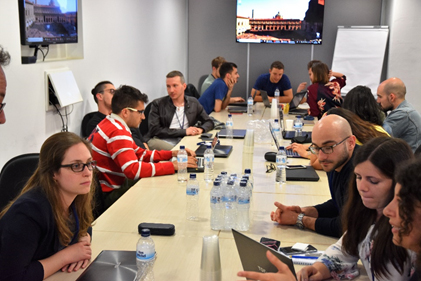
In modern neurosciences the individual researcher has to be familiar with an extended repertoire of methodology to cope with the increasing complexity of research questions. During their long-lasting collaborations over the past years, the partners of the EU-GliaPhD consortium identified a series of research techniques (RT) as essential skills for project success (the partners that are experts of the particular techniques are given in parentheses):

|
RT1 |
Advanced electrophysiology/patch-clamp recording in slices, whole brain preparations, single cells and in vivo and freely moving animal (CNR, FINCB, CdF, INSERM, UKB, CU, AU, HLU) |
| RT2 | Live cell imaging in situ and in vivo incl. Ca2+ imaging and use of confocal/2P microscopy (USAAR, FINCB, CNR, UKB, AU) |
| RT3 | Advanced molecular biology including generation of transgenic animals with cell-type specific modulation of gene activities, incl. also viral vector expertise in vivo (OUS, USAAR, AU) |
| RT4 | Stereotactic brain injections with constructs that selectively target glial cells in the adult brain (UKB, CU, FINCB, OUS) |
| RT5 | Combined cellular expression of fluorescent proteins and/or intracellular dye injections in vivo (USAAR, UKB, INSERM, CdF) |
| RT6 | In-vivo imaging of neuronal-glial networks (USAAR) |
| RT7 | Procedures to evoke epileptic seizures in experimental animal models of human temporal lobe epilepsy as well as absence epilepsy (FINCB, CNR, AU, CU, UKB, OUS) |
| RT8 | Telemetric recordings of EEG and large neuronal ensembles in freely moving mice and rats in vivo (UKB, CU, AU; FINCB, HLU) |
| RT9 | Advanced immunocyto- and -histochemistry (AMC, OUS, HLU) |
| RT10 | Electron microscopy (AMC) |
| RT11 | Quantitative PCR and gene expression profiling (AMC, UKB, OUS, USAAR) |
| RT12 | Developing and optimizing electronic research instrumentation (NPI) |
| RT13 | High-throughput screening of small molecular drugs (HLU) |
| RT14 | Procedures to study post-surgical human temporal lobe epilepsy specimens with immunohistochemical, biomolecular and electrophysiological techniques (FINCB, UKB, AMC) |
| RT15 | Structural and functional magnetic resonance imaging of rodents and human (FINCB, CU, AMC; OUS) |
| RT16 | Behavioural assays to study brain function in rodents (USAAR, HLU). Please note the strong contribution of the industrial partners (underlined) to provide in-depth training in important research techniques |
 Special Research Training Courses based on the distinct expert knowledge of the individual partners are provided by the network to offer intense theoretical and practical introduction into important research techniques as described below. These training modules are offered at reserved time slots (“Training week”) during the granting period to facilitate attendance for all ESRs.
Special Research Training Courses based on the distinct expert knowledge of the individual partners are provided by the network to offer intense theoretical and practical introduction into important research techniques as described below. These training modules are offered at reserved time slots (“Training week”) during the granting period to facilitate attendance for all ESRs.



